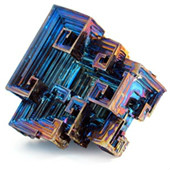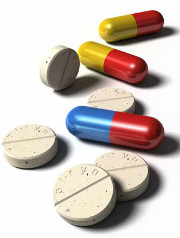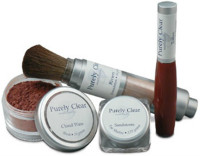 Bismuth is used in a couple of very different applications. The majority is consumed in bismuth alloys, pharmaceuticals and chemicals. The remainder is used in paints, ceramics, catalysts and a variety of minor applications. Taking the US as an example, chemical production accounted for about two thirds of domestic bismuth consumption, principally in pharmaceutical applications.
Bismuth is used in a couple of very different applications. The majority is consumed in bismuth alloys, pharmaceuticals and chemicals. The remainder is used in paints, ceramics, catalysts and a variety of minor applications. Taking the US as an example, chemical production accounted for about two thirds of domestic bismuth consumption, principally in pharmaceutical applications.
 Bismuth is seen as the least toxic heavy metal for humans and is widely used in medical applications for its good antibacterial properties. Bismuth-containing pharmaceuticals are most commonly used in the eradication of Helicobacter pylori, the causative agent for diseases like gastritis, peptic ulcer and even gastric cancer. Bismuth use in pharmaceuticals included bismuth salicylate (the active ingredient in over-the-counter stomach remedies) and other bismuth medicinal compounds used to treat burns, intestinal disorders, and stomach ulcers in humans and animals. The mechanism of action of this substance is still not well documented, although an oligodynamic effect (toxic effect of small doses of heavy metal ions on microbes) may be involved in at least some cases.
Bismuth is seen as the least toxic heavy metal for humans and is widely used in medical applications for its good antibacterial properties. Bismuth-containing pharmaceuticals are most commonly used in the eradication of Helicobacter pylori, the causative agent for diseases like gastritis, peptic ulcer and even gastric cancer. Bismuth use in pharmaceuticals included bismuth salicylate (the active ingredient in over-the-counter stomach remedies) and other bismuth medicinal compounds used to treat burns, intestinal disorders, and stomach ulcers in humans and animals. The mechanism of action of this substance is still not well documented, although an oligodynamic effect (toxic effect of small doses of heavy metal ions on microbes) may be involved in at least some cases.- Other medical uses:
- *A combination of bismuth subsalicylate and bismuth subcitrate are used to treat peptic ulcers.
- *Bibrocathol is an organic bismuth-containing compound used to treat eye infections.
- *Bismuth subgallate, the active ingredient in Devrom, is used as an internal deodorant to treat malodor from flatulence ("gas") andfeces.
- *Bismuth compounds (including sodium bismuth tartrate) were formerly used to treat syphilis
- *"Milk of bismuth" (an aqueous solution of bismuth hydroxide and bismuth subcarbonate) was marketed as an ailimentary cureall in the early 20th century
- *Bismuth subnitrate (Bi5O(OH)9(NO3)4) and bismuth subcarbonate (Bi2O2(CO3)) are also used in medicine.
 Bismuth oxychloride (BiOCl) is occasionally used in cosmetics, as a pigment in paint for eye shadows, hair sprays and nail polishes. This compound is found as the mineral bismoclite and in crystal form contains layers of atoms that refract light chromatically, resulting in an iridescent appearance similar to nacre of pearl. It is this pearlescent quality that renders its suitable for use in cosmetics. It was used as a cosmetic in ancient Egypt and in many places since. Bismuth white (also "Spanish white") can refer to either bismuth oxychloride or bismuth oxynitrate (BiONO3), when used as a white pigment.
Bismuth oxychloride (BiOCl) is occasionally used in cosmetics, as a pigment in paint for eye shadows, hair sprays and nail polishes. This compound is found as the mineral bismoclite and in crystal form contains layers of atoms that refract light chromatically, resulting in an iridescent appearance similar to nacre of pearl. It is this pearlescent quality that renders its suitable for use in cosmetics. It was used as a cosmetic in ancient Egypt and in many places since. Bismuth white (also "Spanish white") can refer to either bismuth oxychloride or bismuth oxynitrate (BiONO3), when used as a white pigment.
- Lead replacement
- The density difference between lead (density 11.32 g•cm−3) and bismuth (density 9.78 g•cm−3) is small enough that for many ballistics and weighting applications, bismuth can substitute for lead. For example, it can replace lead as a dense material in fishing sinkers. It has been used as a replacement for lead in shot, bullets and less-lethal riot gun ammunition. The Netherlands, Denmark, England, Wales, the US, and many other countries now prohibit the use of lead shot for the hunting of wetland birds, as many birds are prone to lead poisoning owing to mistaken ingestion of lead (instead of small stones and grit) to aid digestion, or even prohibit the use of lead for all hunting, such as in the Netherlands. Bismuth-tin alloy shot is one alternative that provides similar ballistic performance to lead. (Another less expensive but also more poorly performing alternative is "steel" shot, which is actually soft iron.) Bismuth's lack of malleability does, however, make it unsuitable for use in expanding hunting bullets.

- Bismuth, as a dense element of high atomic weight, is used in bismuth-impregnated latex shields to shield from X-ray in medical examinations, such as CTs, mostly as it is considered non-toxic.
- The European Union's Restriction of Hazardous Substances Directive (RoHS) for reduction of lead has broadened bismuth's use in electronics as a component of low-melting point solders, as a replacement for traditional tin-lead solders. Its low toxicity will be especially important for solders to be used in food processing equipment and copper water pipes, although it can also be used in other applications including those in the automobile industry, in the EU for example.
- Bismuth has been evaluated as a replacement for lead in free-machining brasses for plumbing applications, although it does not equal the performance of leaded steels.
-
About us
Contact us
Make a suggestion
- Metalpedia is a non-profit website, aiming to broaden metal knowledge and provide extensive reference database to users. It provides users reliable information and knowledge to the greatest extent. If there is any copyright violation, please notify us through our contact details to delete such infringement content promptly.
 Bismuth is used in a couple of very different applications. The majority is consumed in bismuth alloys, pharmaceuticals and chemicals. The remainder is used in paints, ceramics, catalysts and a variety of minor applications. Taking the US as an example, chemical production accounted for about two thirds of domestic bismuth consumption, principally in pharmaceutical applications.
Bismuth is used in a couple of very different applications. The majority is consumed in bismuth alloys, pharmaceuticals and chemicals. The remainder is used in paints, ceramics, catalysts and a variety of minor applications. Taking the US as an example, chemical production accounted for about two thirds of domestic bismuth consumption, principally in pharmaceutical applications.  Bismuth is seen as the least toxic heavy metal for humans and is widely used in medical applications for its good antibacterial properties. Bismuth-containing pharmaceuticals are most commonly used in the eradication of Helicobacter pylori, the causative agent for diseases like gastritis, peptic ulcer and even gastric cancer. Bismuth use in pharmaceuticals included bismuth salicylate (the active ingredient in over-the-counter stomach remedies) and other bismuth medicinal compounds used to treat burns, intestinal disorders, and stomach ulcers in humans and animals. The mechanism of action of this substance is still not well documented, although an oligodynamic effect (toxic effect of small doses of heavy metal ions on microbes) may be involved in at least some cases.
Bismuth is seen as the least toxic heavy metal for humans and is widely used in medical applications for its good antibacterial properties. Bismuth-containing pharmaceuticals are most commonly used in the eradication of Helicobacter pylori, the causative agent for diseases like gastritis, peptic ulcer and even gastric cancer. Bismuth use in pharmaceuticals included bismuth salicylate (the active ingredient in over-the-counter stomach remedies) and other bismuth medicinal compounds used to treat burns, intestinal disorders, and stomach ulcers in humans and animals. The mechanism of action of this substance is still not well documented, although an oligodynamic effect (toxic effect of small doses of heavy metal ions on microbes) may be involved in at least some cases. Bismuth oxychloride (BiOCl) is occasionally used in cosmetics, as a pigment in paint for eye shadows, hair sprays and nail polishes. This compound is found as the mineral bismoclite and in crystal form contains layers of atoms that refract light chromatically, resulting in an iridescent appearance similar to nacre of pearl. It is this pearlescent quality that renders its suitable for use in cosmetics. It was used as a cosmetic in ancient Egypt and in many places since. Bismuth white (also "Spanish white") can refer to either bismuth oxychloride or bismuth oxynitrate (BiONO3), when used as a white pigment.
Bismuth oxychloride (BiOCl) is occasionally used in cosmetics, as a pigment in paint for eye shadows, hair sprays and nail polishes. This compound is found as the mineral bismoclite and in crystal form contains layers of atoms that refract light chromatically, resulting in an iridescent appearance similar to nacre of pearl. It is this pearlescent quality that renders its suitable for use in cosmetics. It was used as a cosmetic in ancient Egypt and in many places since. Bismuth white (also "Spanish white") can refer to either bismuth oxychloride or bismuth oxynitrate (BiONO3), when used as a white pigment.
